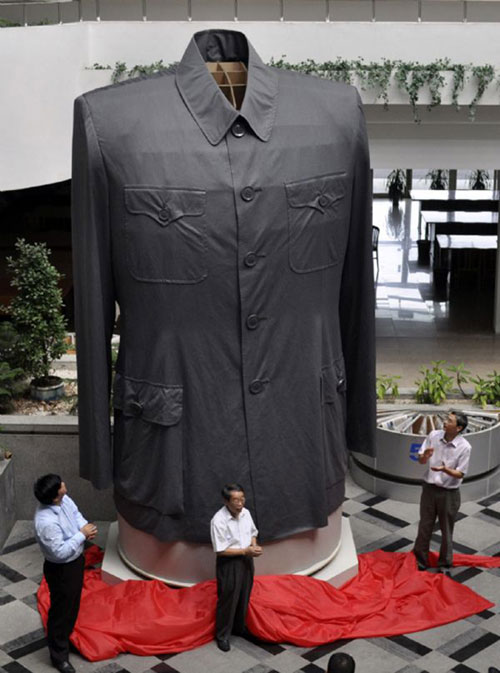Sun Yat-sen suits still in fashion
 0 Comment(s)
0 Comment(s) Print
Print E-mail
Xinhua, October 5, 2011
E-mail
Xinhua, October 5, 2011
|
|
|
A giant grey Chinese tunic, also known as Zhongshan-style suit, is unveiled in Ningbo, east China's Zhejiang Province, Sept. 14, 2011. The suit, six folds the size of an everyday Chinese tunic, is made to commemorate Dr Sun Yat-sen, who led a revolution against China's imperial rule in the early 20th century and found a republic in 1911. Chinese tunic suits were the favorite dress of Dr. Sun Yat-sen, who is also called "Mr. Zhongshan" in the Chinese society, and since became popular in China. [Photo: Xinhua] |
A massive gray Sun Yat-sen suit was unveiled earlier this month in east China's Zhejiang Province to mark the centennial anniversary of the 1911 Revolution led by Sun Yat-sen that ended more than 2,000 years of imperial rule in China.
The suit took tailor Jiang Jiming and four other tailors five months to produce. "We made the suit to commemorate Dr. Sun Yat-sen and to showcase the skills of the Hong tailors," Jiang said.
The 78-year-old Jiang is the sixth generation of the Hong tailors, a group of tailors from Zhejiang's city of Ningbo who made their name by producing the first suit ever made in China, as well as the first Sun Yat-sen suit.
In 1911, protests and armed uprisings took place all over China, protesting the rule of the Qing Dynasty (1644-1911). These events led to the overthrow of the country's last emperor and the founding of the Republic of China on Jan. 1, 1912.
After the 1911 Revolution, Sun Yat-sen felt that the Chinese people needed a new style to match their newfound freedom. He asked the Hong tailors to make a new suit based on his own personal design, according to Chen Wanfeng, vice chairman of the Yinzhou District Museum Association.
With buttons up the neck, a turned-down collar and four symmetrical pockets, the suit was later dubbed as the "Sun Yat-sen suit" in 1925 after Sun's death.
On Oct. 1, 1949, Chairman Mao Zedong wore a Sun Yat-sen suit while announcing the founding of the People's Republic of China, thrusting the suit into the global spotlight.
In the 1950s, the popularity of Sun Yat-sen suits peaked, with people from all walks of life wearing clothes adapted from the style, including the "Mao suit."
The Hong tailors redesigned the Sun Yat-sen suit for Chairman Mao in 1957 with a bigger collar to make it more comfortable. The suit was selected by British newspaper The Independent in 2007 as one of 10 suits that shook the world, along with the wartime flannel suit worn by Winston Churchill and the Beatles' mod-era suits.
In China, the Sun Yat-sen suit has long been a symbol of progress and revolutionary spirit. Even after Western-style suits and jeans became popular after China's reform and opening-up period, Sun Yat-sen suits were still worn by many Chinese for special occasions.
Chinese Ambassador to France Kong Quan worn a dark Sun Yat-sen suit while presenting his credentials to French President Nicolas Sarkozy at the Elysee Palace in Paris in April 2008.
"There are many occasions that require formal dress, but what is the best formal outfit for Chinese people? I believe the Sun Yat-sen suit is the best choice," said Tang Mingxin, vice chairman of the Association of Former Diplomats.
Celebrities and ordinary citizens have also been known to sport Sun Yat-sen suits. Hong Kong action film star Jackie Chan wore one of the suits during an episode of the CNN TalkAsia program in April 2008.
Chan also wore a white Sun Yat-sen suit at the Descendants of the Dragon: Jackie Chan and Friends concert held in Beijing's Bird's Nest stadium on May 1, the first large-scale concert to be held in the stadium after the 2008 Beijing Olympic Games.
Newlywed grooms have also taken to wearing the suits in their wedding photos, with their brides often sporting "cheongsam," a body-hugging one-piece dress that became popular with Chinese women in the 1920s.
"With the diverse styles of clothing available today, it is hard for Sun Yat-sen suits to reclaim their past dominance. However, their aesthetic value and revolutionary spirit still live on," said Xie Ping, head of the department of fashion design at the Beijing Institute of Fashion Technology.







Go to Forum >>0 Comment(s)